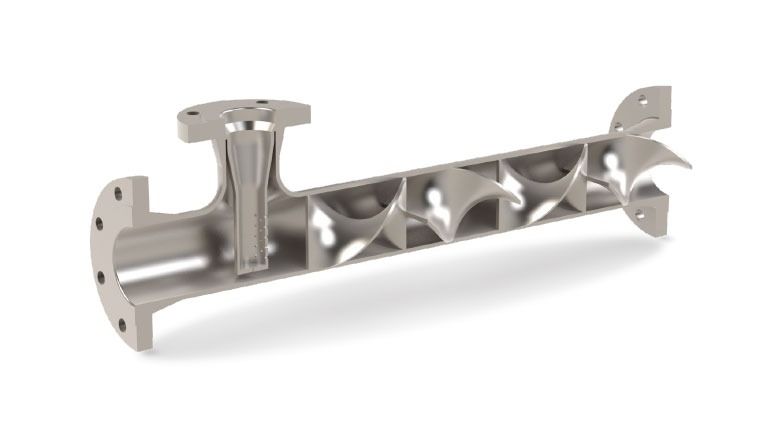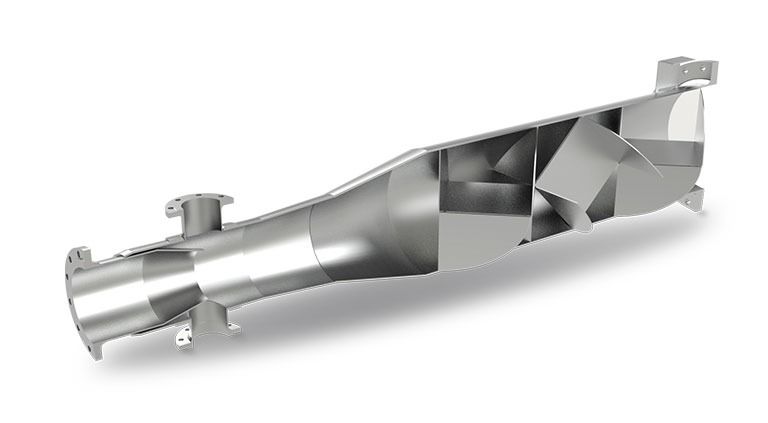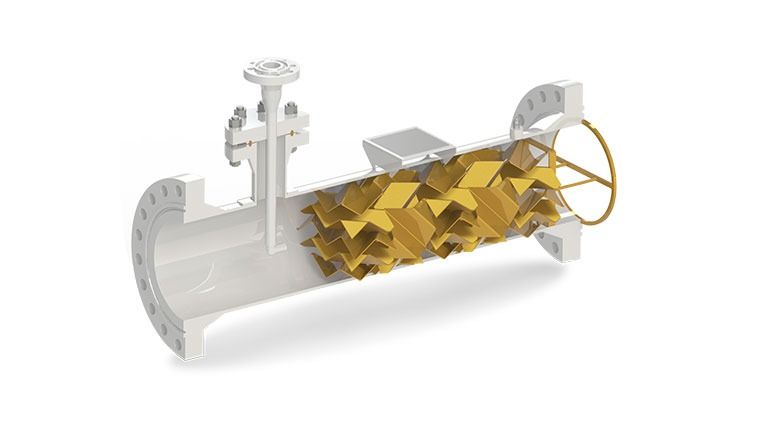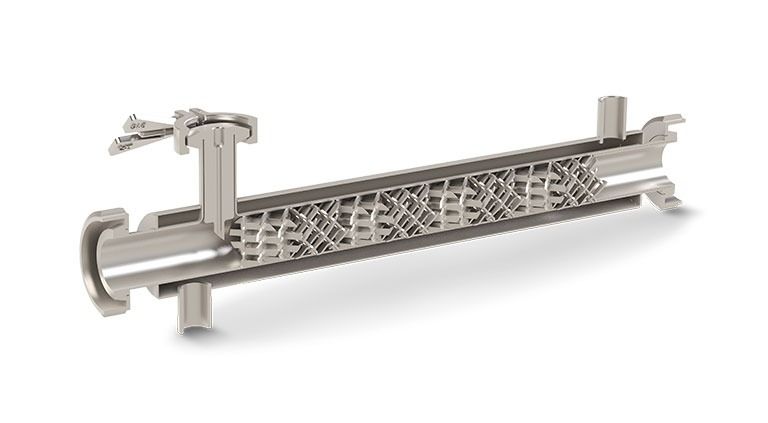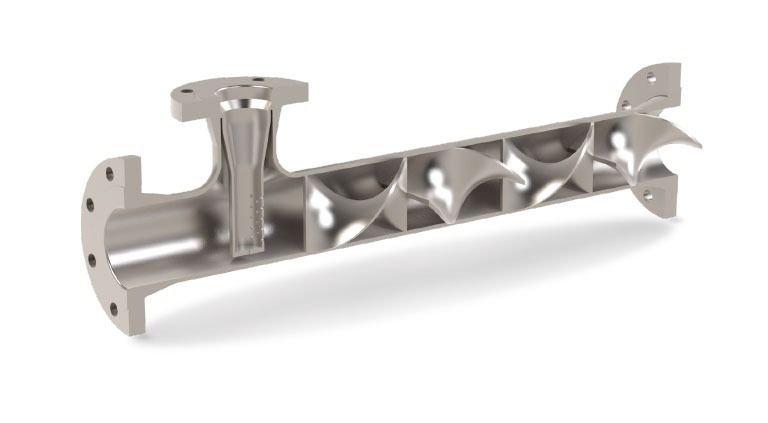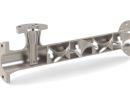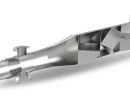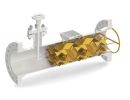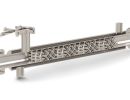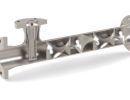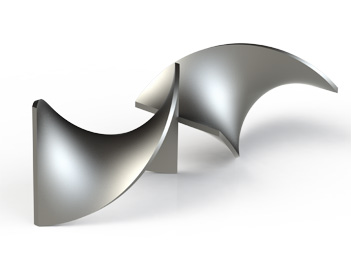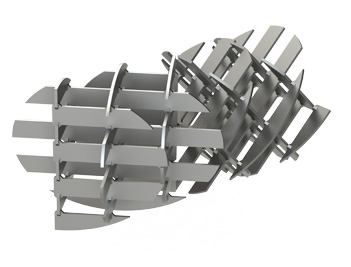Static mixer - bespoke
PRIMIX custom made static mixers are fully customized inline mixers that are totally adapted to the use and process flow. The static tubular mixers can be dimensioned for almost all volume flows, densities, viscosities and substance specific characteristics.
No moving parts (motionless mixer), gaskets and shaft seals
Low energy consumption
Maintenance free and no risk of leakages
Predictable homogenisation
Basic features
Static mixers – tubular mixer or motionless mixers are suitable for:
• Liquids – mixing liquids
• Mixable liquids, such as mixing water and alkali
• Non mixable liquids, such as mixing water and oil
• Liquid – gas mixing, such as water and CO2
• Gas – Gas mixing, such as Flue gas and ammonia
Mixing liquids and gases during a continuous process
With the PRIMIX static tubular mixer you can create a homogeneously distributed mixing of liquids and gases in a continuous process. This takes place entirely without moving parts which means there are no extra power or mechanical elements required. For this reason static mixers are also called motionless inline mixers. The lack of moving parts makes the PRIMIX static mixers very low maintenance, and process-technically extremely safe components.
Simple to clean - static tubular mixers
A PRIMIX static mixer is very simple to clean in a CIP cycle and depending on the process requirements the process can be done totally sanitary/sterile/aseptically. For static mixers with demountable mixer elements the cleaning can be done outside the tube. This can be very useful when processing extremely viscous media. Read more about sanitary mixers.
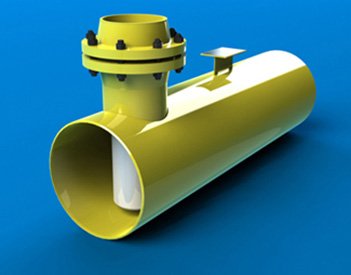
Low energy consumption
In industrial applications liquids and gases are moved through pipelines. The energy needed for this, in the form of pressure, is generated by a pump or compressor. Static mixers are very often fitted into these pipes and the components that need to be mixed or dispensed are added to the main flow directly before the mixer. The static mixer uses energy for mixing the components. This energy emerges as a certain pressure drop across the apparatus and the pressure is maintained by the pump or compressor. Energy consumption can be a significant cost for a process. Besides the homogeneity PRIMIX also calculates the expected fall in pressure beforehand, so that an optimal design is created with a very favourable –indirect– energy consumption.
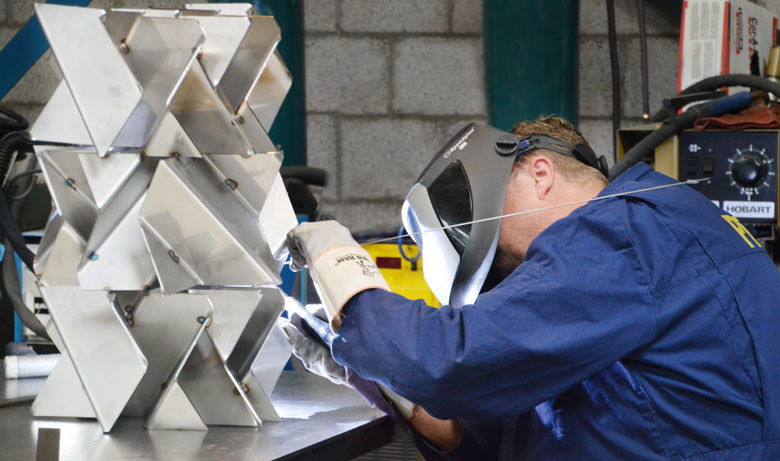
Motionless mixers are maintenance free
What happens to the maintenance schedule after placing a PRIMIX static mixer or heat exchanger inside a process? To be very honest there is no schedule. Because the well thought out and maintenance free design, PRIMIX do not need one. On the other hand service at PRIMIX is at the highest level. For possible future mixer adjustments or for the calculation of processes PRIMIX is more than happy to assist you.
Applications
Static mixers have a very wide range of application within various kinds of industries and are therefore very flexible. In general applications such as technical homogeneous mixing, extraction, washing, reacting, cooling, mixing of viscous media and heating are the most common. But of course other less common applications are also possible. The various media to be mixed or treated are described under the menu item: industries, on the website.
More information about specific media can be found here: static mixers for chemical processes, static mixers for processing polymers and fibers, static mixers for food and drinks, static mixers for water treatment, static mixers for petrochemical, static mixers for pharmaceutical industry, static mixers for BIO technologies
Mixer design
At PRIMIX design is more. It includes the engineering and thinking through the process with the client. Clearly defining the relevant parameters and where necessary daring to ask critical questions. This with the aim of obtaining maximum performance in the process. The intended design is entirely calculated in our own PRIMIX Dynamics software and afterwards is designed in SolidWorks®. The design instructions and calculations are based on strict criteria formulated in the current industrial design standards for high pressure devices. Read more about the PRIMIX design perspective.
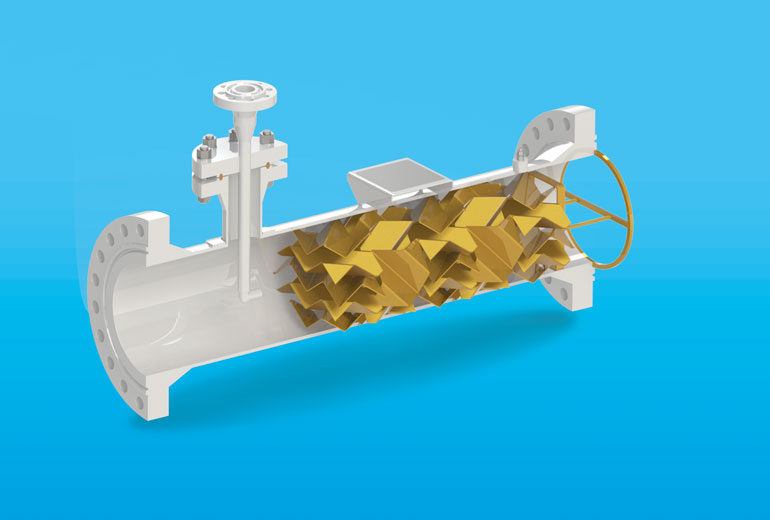
Basic segment shapes of static mixers
Inside the PRIMIX static mixer design four basic segment shapes are used; the Spiral/helical shape, the Quatro shape, the V-shape and the X-shape. More segments form one strand of elements that are placed inside a tube. The attachment of the element strands can take place by means of high-quality welding or soldering techniques, but the elements can also be put in as demountable items. The cleaning of these static tubular mixers can take place totally externally. This can be very practical when processing extreme viscous media.
Characteristics of the mixing elements
Each element has process specific characteristics and depending on the process and the flow diameter a certain type of element will be chosen. Below you will find a short explanation of the segment shapes. You can contact PRIMIX for more information about the segment shapes that have been used in the static mixers.
PMS mixing element:
PMS mixing element
- Standard screw, helical or spiral shaped mixing element. (comparable to Kenics design)
- For static mixers with a diameter of up to approx. 160 mm
- Suitable for basic mixing applications, liquids and gas.
PMQ mixing element:
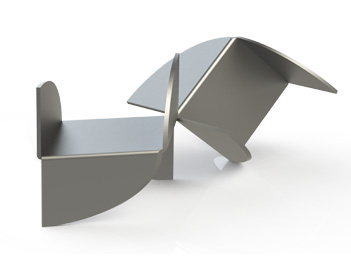
PMQ mixing element
- Quatro shaped mixing element design
- Performances equal to PMS
- For static mixers with a diameter of approx. 160 mm to infinity
- Suitable for basic mixing applications, liquids and gas.
PMX mixing element:
PMX mixing element
- X-crossed type mixing element design
- Suitable for static mixers of all sizes
- Relative high pressure drop and not totally free from blind spots
- Very suitable for high viscosity mixing
- Very good mixing and dispersion – for a very wide range of viscosity
- Reduction of product degradation
- Provides for a compact design of the static mixer
- Suitable for the mixing of sensitive products, with minimal friction tension
- No deposits or accumulation of materials because of cross mixing.
PMV mixing element:
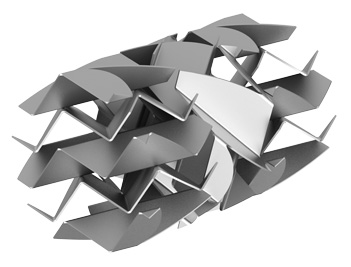
PMV mixing element
- V shaped mixing element design
- For static mixers with a diameter of approx. 50 mm to infinity
- Very suitable for mixing gases or with large contact surface, mostly suitable for gas, but also for liquids
- Suitable for large tube diameters
- Suitable for short mixing lengths
- Minimal space required for mixing or dispersion
- Quick mass transfer through continuous renewal of the interfaces.
Elements provide turbulent or laminar mixing
Depending on the element chosen, mixing can be divided into turbulent and laminar. In case of turbulent mixing we are talking about mixing substances where the viscosity is watery or slightly higher. The flow speeds are relatively high. Radial mixing occurs relatively often, and a technical homogeneous mixture has already been obtained in a short section. Laminar mixing occurs with substances with a high to very high viscosity. The speeds are low and the pressure drops are high. Radial mixing hardly ever occurs. The mixing effects are concentrated around the transition of the mixing elements. There the two layers are forced to mix and then forced into each other so that four layers occur, and so on. At the menu item 'operating principle' you can read more about turbulent and laminar mixing.
Technical specifications
The PRIMIX inline static mixers can, among others, be produced from the following materials:
- (Low temperature) carbon steel and low alloyed steel, for example A106 Gr. B, A333 Gr. 6, A335 Gr. P11, etc.
- Stainless steel, e.g. 316L(1.4404), 304L(1.4307), 321(1.4541), 316Ti (1.4571), etc.
- PTFE or glass (glazed) covered carbon steel or stainless steel
- Steel with fusion bond coatings or halar coating
- Duplex & super duplex (1.4462)
- Exotic materials such as: alloys, Hastelloy®, titanium, nickel, Incoloy®, alloys
- Glass fibre reinforced synthetic materials (GRP) with a chemical barrier of uPVC, cPVC, PE covering
- Synthetic materials, e.g. uPVC, cPVC, PP, HDPE, PVDF, PTFE
- Silicate glass
Surface finish static mixers:
Surface finish static mixers
The surface of the static mixers can be finished, treated or cleaned to specification. A number of treatment techniques are:
- Staining and passivating
- Grinding & glass-grit blasting or sandblasting
- Honed finish for a perfectly smooth surface
- Electrolytic polishing
- Chromium plated
- Ultrasonic cleaning
Applied flanges and connectors:
Applied flanges and connectors
The static mixers can be provided with various types of flanges and connectors. The connection will depend on the process, the tube diameter and the desired seal.
Connector type (more available on request)
- Bevelled weld ends ASME B16.25
- EN1092‐1 flanges. All types and pressure classes
- ASME B16.5, B16.47 flanges. All types and pressure classes
- Loose flanges and sleeves for plastic construction materials
- Sanitary flanges, e.g. DIN11851, bio-connect, tri‐clamps, aseptic DIN11864, SMS
- Thread ends, e.g. union joints, Swagelok®
Injectors:
Injectors
In processes in which the mixing ratios are wide apart from each other or in which physical material properties vary greatly, it is important to add the additive to the main flow via an injection unit. One possibility could be a centre line injection, but also injectors in the shape of a clarinet are interesting; the many possibilities can also be supplied as a demountable version. The advantage of an injector is that the additive is injected into the main flow at an ideal point, before the first mixing element, so that the mixing action takes place significantly more efficiently. PRIMIX can advise you in choosing the most ideal version for your application.
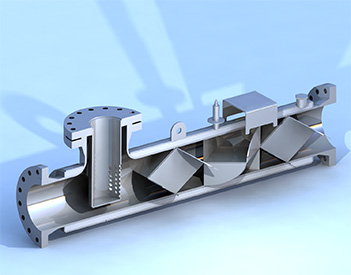
Downloads
Brochure and leaflet
![]() Static mixer leaflet (English)
Static mixer leaflet (English)
![]() Staattiset sekoittimet ja lämmönvaihtimet (Suomalainen)
Staattiset sekoittimet ja lämmönvaihtimet (Suomalainen)
![]() Mieszacze statyczne i wymienniki ciepła w jednym (Polski)
Mieszacze statyczne i wymienniki ciepła w jednym (Polski)
![]() Static mixer leaflet (Taiwanese)
Static mixer leaflet (Taiwanese)
Case study data sheets
![]() #50 Static mixer for H2SO4 Dilution
#50 Static mixer for H2SO4 Dilution
![]() #51 Static mixer for biodiesel production
#51 Static mixer for biodiesel production
![]() #53 Polyelectrolyte dosing system
#53 Polyelectrolyte dosing system
![]() #54 Cip static mixer for food homogenization
#54 Cip static mixer for food homogenization
![]() #55 BS&W / Custody transfer mixing
#55 BS&W / Custody transfer mixing
![]() #57 Multi-stage inline dosing system
#57 Multi-stage inline dosing system
Certificates
Quote request

 English
English  Deutsch
Deutsch  Español
Español  Français
Français  Nederlands
Nederlands 